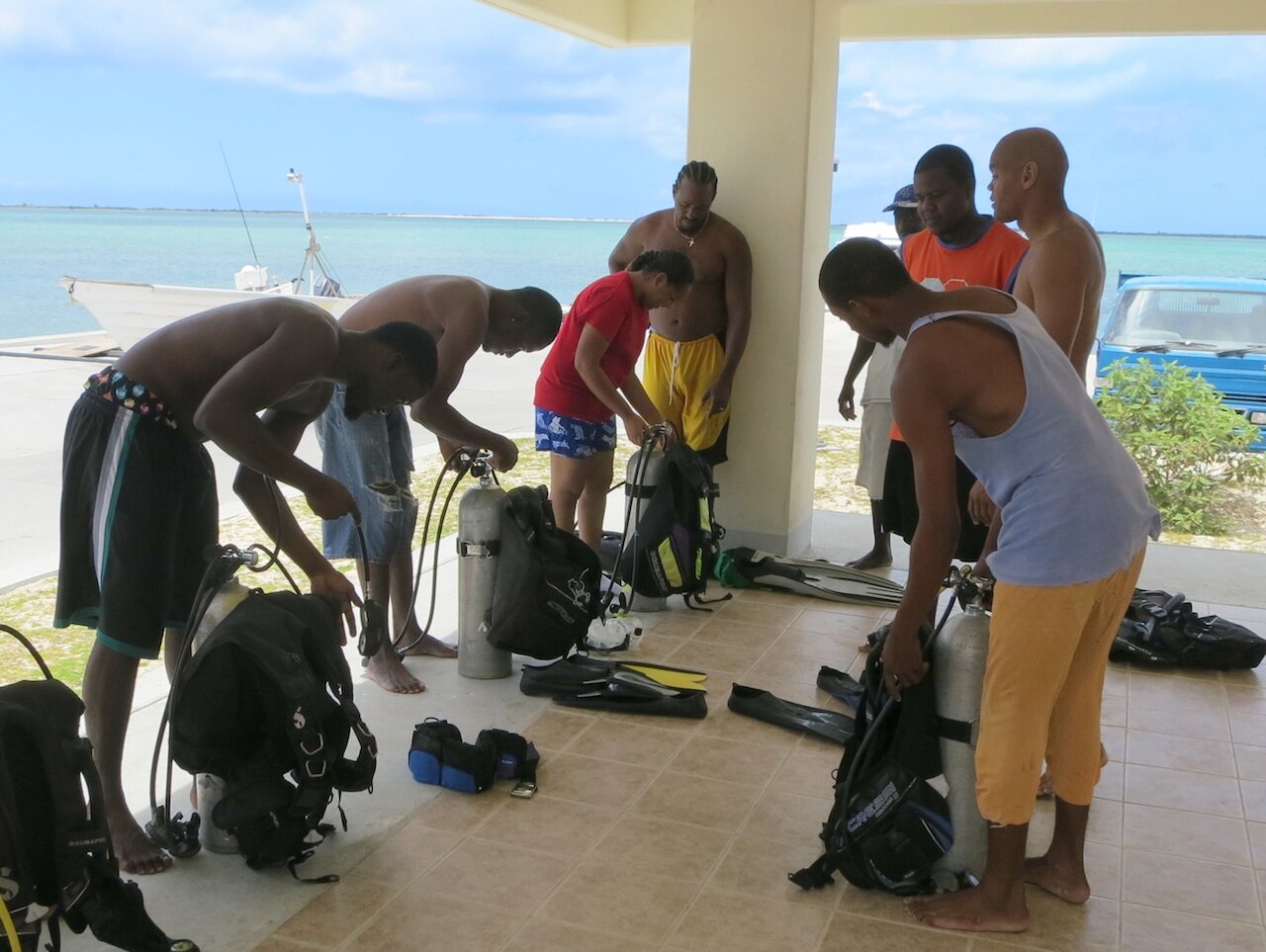The Good, Bad, Ugly, and Hope of SCUBA Diving on Barbuda
Originally published on the (now archived) National Geographic blog.
April 15, 2013
Learning to assemble SCUBA gear.
I hear the SCUBA instructor say: “Buddy check! Weights? Mask? Snorkel on the left. Don’t touch the coral; it is a living thing and you will kill it. Don’t touch anything underwater! Hover.”
Kurt Brown helping Rishma Mansingh check her gear before the class makes its first dive.
We recently ran a SCUBA certification course on Barbuda as part of the Blue Halo Initiative there. Building local capacity for monitoring the island’s ocean resources and implementing measures for sustainable management is the part of the Initiative that I am most excited about, and this was the first step in that process.
Attentive students receiving an introduction to SCUBA diving from instructor Kurt Brown of Twin Divers Curaçao.
It may also be the most fun step, thanks to Kurt Brown, dive instructor extraordinaire and co-owner of Twin Divers in Curaçao (and translator for my Ph.D. research interviewing Curaçaoan fishermen). His sense of humor combined with his dedication to conservation, and seriousness about safety were the perfect fit.
Barbuda now has eleven newly certified PADI Advanced Divers amongst the Fisheries Division, Codrington Lagoon National Park, and Tourism Department. They are good! And they made good use of the gear Antigua dive shops Extreme Marine, Aquanaut Divers, and Jolly Dive donated for the course. From the very first dive they were always helping each other, solving problems, rapidly becoming self-reliant. They are ready to go out with the team of marine biologists that is coming down this week to assess the island’s lobster, conch, fish, and coral. The new divers will be trained in scientific protocols, so they can do subsequent monitoring themselves.
However, along with this good, there is the bad and the ugly. There is also ample reason for hope.
The Bad: I already knew it, but hearing Kurt say it made it sink in: “I didn’t expect the reef to be dead like that. The northern reefs are a desert, very few fish. There is so little coral. All we saw was about nine fish, and one was a [invasive] lionfish. And the fish run from you. They’re scared. If they see a person they know it’s bad news because of all the spearfishing.”
This is in contrast to reefs on Curaçao where Kurt usually dives, which are among the healthiest in the Caribbean, where spearfishing is prohibited, and where there is strikingly more coral and fish.
A dead coral reef on Barbuda (left) and a healthy one on Curaçao (right).
The Ugly: I had heard inklings of the wildly dangerous diving that lobster and conch fishermen were doing here, so I organized evening seminars so Kurt could talk with them about safe techniques. Per Kurt, “It was scary to hear how these guys are diving. They had no knowledge of how long they were staying down or the safe diving limits. It’s only a matter of time before someone dies.”
Evening SCUBA safety seminar for fishermen.
Some fishermen are going through six tanks a day, spending four or more hours at 70 to 100 feet, switching out tanks underwater. No safety stops – they just come straight up when they run out of air, when they feel the regulator start to breath hard. When we explained how dive tables calculate safe diving limits, the fishermen explained how obeying the tables would make it hard to make a living, that by diving by those rules they wouldn’t be able to catch enough lobster.
We explained that their diving habits put them at risk for paralysis, erectile dysfunction, and death. They get the bends, but don’t go to a recompression chamber – they just wait (for weeks) for the searing pain to subside then start diving again.We gave pointers for ways they could at least lower their risk: plan and time their dives, safety stops, rotate divers for longer surface intervals, and take days off to recover. I cried when I got home that night. I woke up the next morning thinking about the economic forces that drive this risky behavior, the same forces that drive unsustainable fishing – unregulated foreign demand, short-term thinking, how the lack of ownership of the resource reduces incentives for stewardship. Ocean conservation is much more about people and dollars than it is about fish.
SCUBA instructor Kurt Brown teaching the dive tables to Barbudan fishermen.
The Hope: These driving forces could potentially be addressed with management measures such as quotas, closed seasons, fish sanctuaries (where fishing is prohibited), endowing fishers with property rights in the fishery, and Fair Trade principles. There are solutions, scenarios under which (at least to some degree) you can have your fish and eat them too.
Despite their initial reticence, fishermen were glad to learn the dive tables and be able to keep the ones we gave them at the seminar. Three of them joined the dive class and learned about the safe way to dive. There are now fourteen newly certified divers on the island who can teach others about what it means to dive within safe limits. We encouraged them all to spread the word.
Another reason for hope is that some reefs around Barbuda are in better shape than others. Kurt said of Coco Point, “We saw sting rays and spotted eagle rays and more fish there, because there was more reef. That was the best place to dive because there was live coral.”
And Kurt is a role model: a successful, young, black entrepreneur who makes a living from the ocean without killing anything in it. If fish sanctuaries and improved management can bring back the reefs here, maybe some of these new divers can follow in his footsteps. Maybe one of them will open the first dive shop on the island.
Happy, newly certified SCUBA divers.







